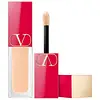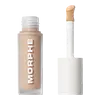What's inside
What's inside
 Key Ingredients
Key Ingredients

 Benefits
Benefits

 Concerns
Concerns

 Ingredients Side-by-side
Ingredients Side-by-side

Water
Skin ConditioningCoco-Caprylate/Caprate
EmollientHydrogenated Polyisobutene
EmollientGlycerin
HumectantPropanediol
SolventPropylene Glycol
HumectantSorbitan Isostearate
EmulsifyingPolyglyceryl-6 Polyricinoleate
EmulsifyingSynthetic Fluorphlogopite
Alumina
AbrasivePhenoxyethanol
PreservativeMagnesium Sulfate
Disodium Stearoyl Glutamate
CleansingParaffin
PerfumingHydroxyacetophenone
AntioxidantDisteardimonium Hectorite
StabilisingCera Microcristallina
Emulsion StabilisingCaprylyl Glycol
EmollientSilica Silylate
EmollientParfum
MaskingSynthetic Wax
AbrasiveCaffeine
Skin ConditioningTrisodium Ethylenediamine Disuccinate
Tocopherol
AntioxidantAluminum Hydroxide
EmollientTin Oxide
AbrasiveMagnesium Silicate
AbsorbentLinalool
PerfumingLimonene
PerfumingCitronellol
PerfumingBenzyl Alcohol
PerfumingHelianthus Annuus Seed Oil
EmollientWater, Coco-Caprylate/Caprate, Hydrogenated Polyisobutene, Glycerin, Propanediol, Propylene Glycol, Sorbitan Isostearate, Polyglyceryl-6 Polyricinoleate, Synthetic Fluorphlogopite, Alumina, Phenoxyethanol, Magnesium Sulfate, Disodium Stearoyl Glutamate, Paraffin, Hydroxyacetophenone, Disteardimonium Hectorite, Cera Microcristallina, Caprylyl Glycol, Silica Silylate, Parfum, Synthetic Wax, Caffeine, Trisodium Ethylenediamine Disuccinate, Tocopherol, Aluminum Hydroxide, Tin Oxide, Magnesium Silicate, Linalool, Limonene, Citronellol, Benzyl Alcohol, Helianthus Annuus Seed Oil
Water
Skin ConditioningOctyldodecanol
EmollientPropanediol
SolventGlycerin
HumectantDiphenylsiloxy Phenyl Trimethicone
Skin ConditioningCoco-Caprylate/Caprate
EmollientSimmondsia Chinensis Seed Oil
EmollientPolyglyceryl-3 Polyricinoleate
EmulsifyingIsododecane
EmollientAcrylates/Dimethicone Copolymer
Skin ConditioningGlyceryl Caprylate
EmollientSorbitan Isostearate
EmulsifyingDisodium Stearoyl Glutamate
CleansingSodium Chloride
MaskingDisteardimonium Hectorite
StabilisingAluminum Hydroxide
EmollientPolyhydroxystearic Acid
EmulsifyingSodium Hyaluronate
HumectantAlgae Extract
EmollientArnica Montana Flower Extract
MaskingTocopherol
AntioxidantLeuconostoc/Radish Root Ferment Filtrate
AntimicrobialTremella Fuciformis Extract
HumectantPentylene Glycol
Skin Conditioning1,2-Hexanediol
Skin ConditioningFructose
HumectantUrea
BufferingCitric Acid
BufferingSodium Hydroxide
BufferingEthyl Hexanediol
SolventIpomoea Batatas Root Extract
Skin ConditioningHydroxyacetophenone
AntioxidantMaltose
MaskingSodium PCA
HumectantSodium Lactate
BufferingTrehalose
HumectantAllantoin
Skin ConditioningGlucose
HumectantTitanium Dioxide
Cosmetic ColorantCI 77491
Cosmetic ColorantCI 77492
Cosmetic ColorantCI 77499
Cosmetic ColorantWater, Octyldodecanol, Propanediol, Glycerin, Diphenylsiloxy Phenyl Trimethicone, Coco-Caprylate/Caprate, Simmondsia Chinensis Seed Oil, Polyglyceryl-3 Polyricinoleate, Isododecane, Acrylates/Dimethicone Copolymer, Glyceryl Caprylate, Sorbitan Isostearate, Disodium Stearoyl Glutamate, Sodium Chloride, Disteardimonium Hectorite, Aluminum Hydroxide, Polyhydroxystearic Acid, Sodium Hyaluronate, Algae Extract, Arnica Montana Flower Extract, Tocopherol, Leuconostoc/Radish Root Ferment Filtrate, Tremella Fuciformis Extract, Pentylene Glycol, 1,2-Hexanediol, Fructose, Urea, Citric Acid, Sodium Hydroxide, Ethyl Hexanediol, Ipomoea Batatas Root Extract, Hydroxyacetophenone, Maltose, Sodium PCA, Sodium Lactate, Trehalose, Allantoin, Glucose, Titanium Dioxide, CI 77491, CI 77492, CI 77499
Ingredients Explained
These ingredients are found in both products.
Ingredients higher up in an ingredient list are typically present in a larger amount.
Aluminum Hydroxide is a form of aluminum. It can be naturally found in nature as the mineral gibbsite. In cosmetics, Aluminum Hydroxide is used as a colorant, pH adjuster, and absorbent.
As a colorant, Aluminum Hydroxide may add opacity, or reduce the transparency. Aluminum hydroxide is contains both basic and acidic properties.
According to manufacturers, this ingredient is an emollient and humectant. This means it helps hydrate the skin.
In medicine, this ingredient is used to help relieve heartburn and help heal ulcers.
There is currently no credible scientific evidence linking aluminum hydroxide in cosmetics to increased cancer risk.
Major health organizations allow the use of aluminum hydroxide in personal care products and have not flagged it as a carcinogenic risk at typical usage levels.
Learn more about Aluminum HydroxideCoco-Caprylate/Caprate is created from fatty coconut alcohol, caprylic acid, and capric acid.
It is a lightweight emollient. Emollients create a thin barrier on the skin to trap moisture in. This helps keep your skin hydrated and soft.
Once applied, Coco-Caprylate/Caprate is absorbed quickly and leaves a silky feel.
Coco-Caprylate/Caprate may not be fungal acne safe.
Learn more about Coco-Caprylate/CaprateDSG is used as a surfactant.
Surfactants are cleansing ingredients that help remove oil, dirt, and other impurities from the skin. They work by reducing surface tension between water and oils/dirt to allow them to be easily rinsed away.
Disteardimonium Hectorite comes from the clay mineral named hectorite. It is used to add thickness to a product.
It can also help stabilize a product by helping to disperse other ingredients.
Hectorite is a rare, white clay mineral.
Learn more about Disteardimonium HectoriteGlycerin is already naturally found in your skin. It helps moisturize and protect your skin.
A study from 2016 found glycerin to be more effective as a humectant than AHAs and hyaluronic acid.
As a humectant, it helps the skin stay hydrated by pulling moisture to your skin. The low molecular weight of glycerin allows it to pull moisture into the deeper layers of your skin.
Hydrated skin improves your skin barrier; Your skin barrier helps protect against irritants and bacteria.
Glycerin has also been found to have antimicrobial and antiviral properties. Due to these properties, glycerin is often used in wound and burn treatments.
In cosmetics, glycerin is usually derived from plants such as soybean or palm. However, it can also be sourced from animals, such as tallow or animal fat.
This ingredient is organic, colorless, odorless, and non-toxic.
Glycerin is the name for this ingredient in American English. British English uses Glycerol/Glycerine.
Learn more about GlycerinHydroxyacetophenone is antioxidant with skin conditioning and soothing properties. It also boosts the efficiency of preservatives.
This ingredient is not irritating or sensitizing.
Propanediol is an all-star ingredient. It softens, hydrates, and smooths the skin.
It’s often used to:
Propanediol is not likely to cause sensitivity and considered safe to use. It is derived from corn or petroleum with a clear color and no scent.
Learn more about PropanediolSorbitan Isostearate is an emulsifer and cleaning agent. It is created from isostearic acid and sorbitol.
As an emulsifier, Sorbitan Isostearate prevents oils and water from separating.
Due to its isostearic acid base, it may not be safe for Malassezia or fungal acne.
Learn more about Sorbitan IsostearateTocopherol (also known as Vitamin E) is a common antioxidant used to help protect the skin from free-radicals and strengthen the skin barrier. It's also fat soluble - this means our skin is great at absorbing it.
Vitamin E also helps keep your natural skin lipids healthy. Your lipid skin barrier naturally consists of lipids, ceramides, and fatty acids. Vitamin E offers extra protection for your skin’s lipid barrier, keeping your skin healthy and nourished.
Another benefit is a bit of UV protection. Vitamin E helps reduce the damage caused by UVB rays. (It should not replace your sunscreen). Combining it with Vitamin C can decrease sunburned cells and hyperpigmentation after UV exposure.
You might have noticed Vitamin E + C often paired together. This is because it is great at stabilizing Vitamin C. Using the two together helps increase the effectiveness of both ingredients.
There are often claims that Vitamin E can reduce/prevent scarring, but these claims haven't been confirmed by scientific research.
Learn more about TocopherolWater. It's the most common cosmetic ingredient of all. You'll usually see it at the top of ingredient lists, meaning that it makes up the largest part of the product.
So why is it so popular? Water most often acts as a solvent - this means that it helps dissolve other ingredients into the formulation.
You'll also recognize water as that liquid we all need to stay alive. If you see this, drink a glass of water. Stay hydrated!
Learn more about Water